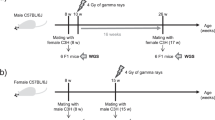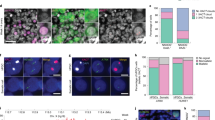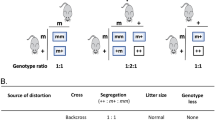Abstract
Fragile X syndrome results from the expansion of the CGG repeat in the FMR1 gene. Expansion has been suggested to be a postzygotic event with the germline protected. From an analysis of intact ovaries of full mutation fetuses, we now show that only full expansion alleles can be detected in oocytes (but in the unmethylated state). Similarly, the testes of a 13-week full mutation fetus show no evidence of premutations while a 17-week full mutation fetus exhibits some germ cells with attributes of premutations. These data discount the hypothesis that the germline is protected from full expansion and suggest full mutation contraction in the immature testis. Thus, full expansion may already exist in the maternal oocyte, or postzygotic expansion, if it occurs, arises quite early in development prior to germline segregation.
This is a preview of subscription content, access via your institution
Access options
Subscribe to this journal
Receive 12 print issues and online access
$209.00 per year
only $17.42 per issue
Buy this article
- Purchase on Springer Link
- Instant access to full article PDF
Prices may be subject to local taxes which are calculated during checkout
Similar content being viewed by others
References
Warren, S.T. & Nelson, D.L. Advances in molecular analysis of Fragile X Syndrome. JAMA 27, 536–542 (1994).
Warren, S.T. & Ashley, C.T. Triplet repeat expansion mutations: the example of fragile X syndrome. Annu Rev Neurosci. 18, 77–99 (1995).
Fu, Y.H. et al. Variation of the CGG repeat at the fragile X site results in genetic instability: resolution of the Sherman paradox. Cell 67, 1047–1058 (1991).
Snow, K. et al. Analysis of a CGG sequence at the FMR-1 locus in fragile X families and in the general population. Am. J. Hum. Genet. 53, 1217–1228 (1993).
Kunst, C.B. & Warren, S.T. Cryptic and polar variation of the fragile X repeat could result in predisposing normal alleles. Cell 77, 853–861 (1994).
Rousseau, F. et al. Direct diagnosis by DNA analysis of the fragile X syndrome of mental retardation. N. Engl. J. Med. 325, 1673–1681 (1991).
Sutcliffe, J.S. et al. DNA methylation represses FMR-1 transcription in fragile X syndrome. Hum. Mol. Genet. 1, 397–400 (1992).
Pieretti, M. et al. Absence of expression of the FMR1 gene in fragile X syndrome. Cell 66, 817–822 (1991).
Reyniers, E. et al. The full mutation in the FMR-1 gene of male fragile X patients is absent in their sperm. Nature Genet. 4, 143–146 (1993).
Bakker, C.E. et al. FMR1 knockout mice: a model to study fragile X syndrome. Cell 78, 23–33 (1994).
Wöhrle, D. et al. Genotype mosaicism in fragile X tissues. Hum. Genet. 89, 114–116 (1992).
Wöhrle, D., Hennig, I., Vogel, W. & Steinbach, P. Mitotic stability of fragile X mutations in differentiated cells indicates early post-conceptional trinucleotide repeat expansion. Nature Genet. 4, 140–142 (1993).
Devys, D. et al. Analysis of full mutation fragile X mutations in fetal tissues and monozygotic twins indicate that abnormal methylation and somatic heterogeneity are established early in development. Am. J. Med. Genet. 43, 208–216 (1992).
Nelson, D.L. & Warren, S.T. Trinucleotide repeat instability: when and where? Nature Genet. 4, 107–108 (1993).
Ashley, A. & Sherman, S.L. Population dynamics of a meiotic/mitotic expansion model for the fragile X syndrome. Am. J. Hum. Genet. 57, 1414–1425 (1995).
Rousseau, F., Roblo, L.J., Rouillard, P. & Der Kaloustain, V.M. No mental retardation in a man with 40%; abnormal methylation at the FMR-1 locus and transmission of sperm cell mutations as premutations. Hum. Mol. Genet. 3, 927–930 (1994).
MacDonald, M.E. et al. Gametic but not somatic instability of CAG repeat length in Huntington's disease. J. Med. Genet. 30, 982–986 (1993).
Baker, T.G. A quantitative and cytological study of germ cells in human ovaries. Proc R Soc. London B 158, 417–433 (1963).
Monk, M., Boubelik, M. & Lehnert, S. Temporal and regional changes in DNA methylation in the embryonic, extraembryonic, and germ cell lineages during mouse development. Development 99, 371–382 (1987).
Driscoll, D.J. & Migeon, B.R. Sex difference in methylation of single copy genes in human meiotic germ cells: implications for X chromosome inactivation, parental imprinting, and origin of CpG mutations. Somat. Cell. Mol. Genet. 16, 267–282 (1990).
Luo, S., Robinson, J.C., Reiss, A.L. & Migeon, B.R. DNA methylation of the fragile X locus in somatic and germ cells during fetal development: relevance to the fragile X syndrome and X inactivation. Somat. Cell. Mol. Genet. 19, 393–404 (1993).
Migeon, B.R., Holland, M.M., Driscoll, D.J. & Robinson, J.C. rogrammed demethylation in CpG islands during human fetal development. Somat. Cell. Mol. Genet. 17, 159–168 (1991).
Beaumont, H.M. & Mandel, A.M. A quantitative study of primordial germ cells in the male rat. J.Embryol.Exp.Morph. 11, 715–740 (1963).
Devys, D. et al. The FMR1 protein is cytoplasmic, most abundant in neurons, and appears normal in carriers of the fragile X premutation. Nature Genet. 4, 335–340 (1993).
Verheij, C. et al. Characterization of FMR1 proteins isolated from different tissues. Hum. Mol. Genet. 4, 895–901 (1995).
Bächner, D. et al. Enhanced FMR1 expression in testis. Nature Genet. 4, 115–116 (1993).
de Graaff, E. et al. Instability of the CGG repeat and expression of the FMR1 protein in a male fragile X patient with a lung tumor. Am. J. Hum. Genet. 57, 609–618 (1995).
Bächner, D. et al. Enhanced expression of the murine FMR1 gene during germ cell proliferation suggests a special function in both the male and female gonad. Hum. Mol. Genet. 2, 2043–2050 (1993).
Byskov, A.G. Primordial germ cells and regulation of meiosis. in Germ cells and Fertilization, (eds. Austin, C. R., & Short R. V.) 1–16 (Cambridge, U.K., Cambridge Univ. Press, 1982).
Fisch, G.S. et al. The fragile X premutation in carriers and its effect on mutation size in offspring. Am. J. Hum. Genet. 56, 1147–1155 (1995).
La Spada, A.R. et al. Meiotic stability and genotype-phenotype correlation of the trinucleotide repeat in X-linked spinal and bulbar muscular atrophy. Nature Genet. 2, 301–304 (1992).
Andrew, S.E. et al. The relationship between trinucleotide (CAG) repeat length and clinical features of Huntington's disease. Nature Genet. 4, 398–403 (1993).
Chung, M.Y., Ranum, L.P.W., Duvick, L.A., Servadio, A. & Zoghbi, H.Y. Evidence for a mechanism predisposing to intergenerational CAG repeat instability in spinocerebellar ataxia type I. Nature Genet. 5, 254–258 (1993).
Kawaguchi, Y. et al. CAG expansions in a novel gene for Machado-Joseph disease at chromosome 14q32.1. Nature Genet. 8, 221–228 (1994).
Koide, R. et al. Unstable expansion of CAG repeat in hereditary dentatorubral-pallidoluysian atrophy (DRPLA). Nature Genet. 6, 9–13 (1995).
Chandley, A.C. On the parental origin of de novo mutation in man. J. Med. Genet. 28, 217–223 (1991).
Rousseau, F., Heitz, D., Oberle, I. & Mandel, J.L. Selection in blood cells from female carriers of the fragile X syndrome: inverse correlation between age and proportion of active X chromosomes carrying the full mutation. J. Med. Genet. 28, 830–836 (1991).
Laird, C.D. Proposed mechanism of inheritance and expression of the fragile X syndrome mental retardation. Genetics 117, 587–599 (1987).
Morton, N.E. & MacPherson, J.N. Population genetics of the fragile X syndrome: multiallelic model for the FMR1 locus. Proc. Natl. Acad. Sci. USA 89, 4215–4217 (1992).
Razin, A. & Shemer, R. DNA methylation in early development. Hum. Mol. Genet. 4, 1751–1755 (1995).
Verkerk, A.J.M.H. et al. Identification of a gene (FMR-1) containing a CGG repeat coincident with a breakpoint cluster region exhibiting length variation in fragile X syndrome. Cell 65, 905–914 (1991).
Brown, W.T. et al. Rapid fragile X carrier screening and prenatal diagnosis using a nonradioactive PCR test. JAMA 270, 1569–1575 (1993).
Author information
Authors and Affiliations
Corresponding author
Rights and permissions
About this article
Cite this article
Malter, H., Iber, J., Willemsen, R. et al. Characterization of the full fragile X syndrome mutation in fetal gametes. Nat Genet 15, 165–169 (1997). https://doi.org/10.1038/ng0297-165
Received:
Accepted:
Issue Date:
DOI: https://doi.org/10.1038/ng0297-165
This article is cited by
-
DMPK hypermethylation in sperm cells of myotonic dystrophy type 1 patients
European Journal of Human Genetics (2022)
-
Fragile X syndrome: a preclinical review on metabotropic glutamate receptor 5 (mGluR5) antagonists and drug development
Psychopharmacology (2014)
-
Mechanisms of trinucleotide repeat instability during human development
Nature Reviews Genetics (2010)
-
Understanding what determines the frequency and pattern of human germline mutations
Nature Reviews Genetics (2009)
-
Fragile X syndrome
European Journal of Human Genetics (2008)



